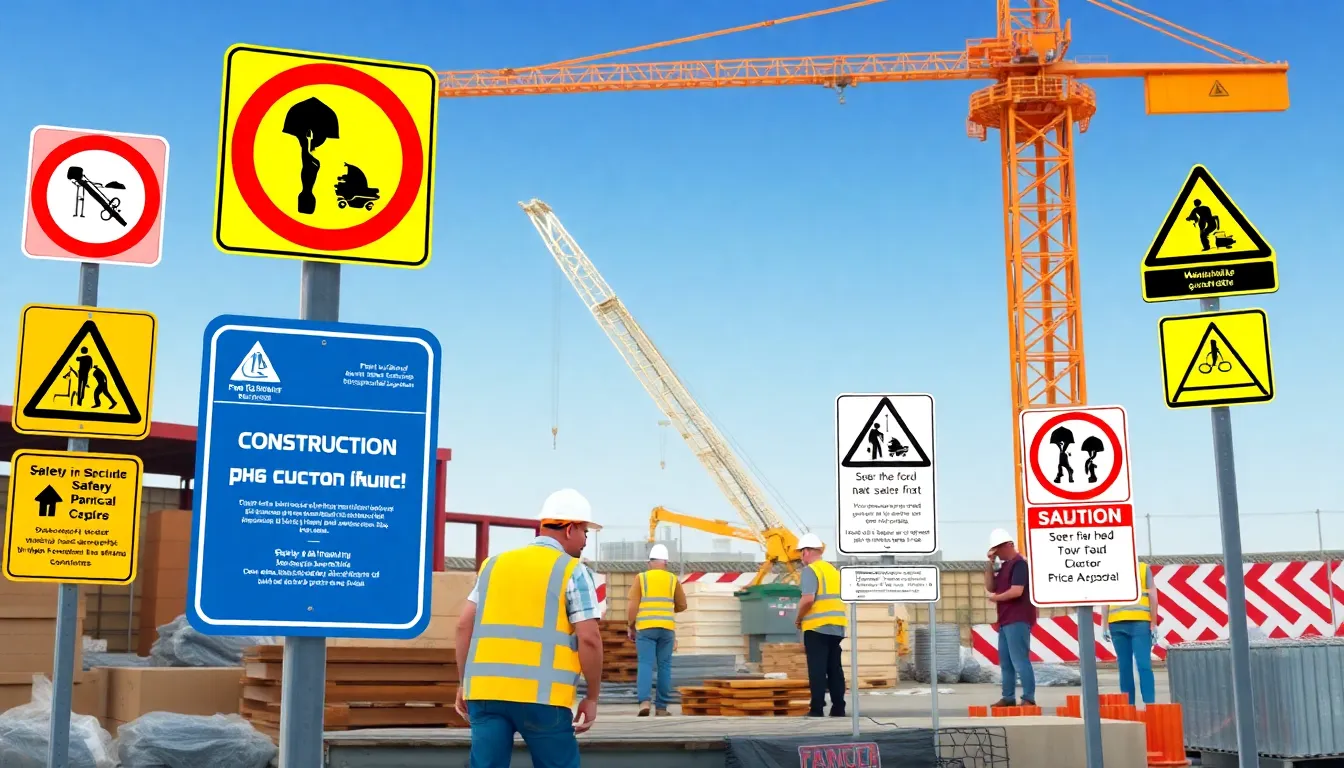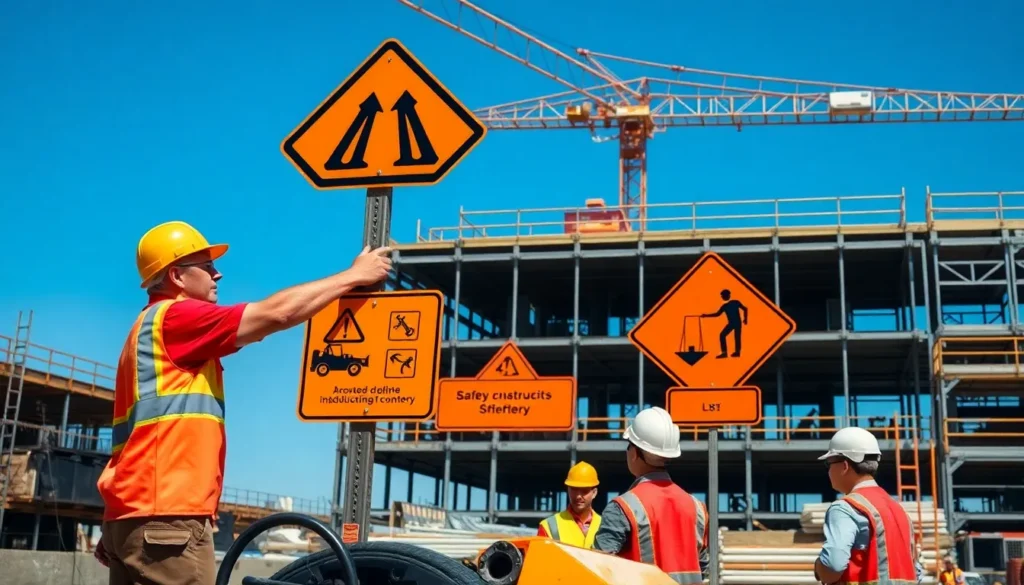Table of Contents
ToggleWhen it comes to construction sites, a big pile of bricks and a hard hat aren’t the only essentials. Enter the unsung hero of the building world: construction signs. These vibrant pieces of plastic or metal aren’t just there to look pretty; they’re vital for safety, direction, and even a touch of humor. After all, who wouldn’t want to chuckle at a sign that warns “Caution: Men at Work”?
Construction signs serve as the first line of defense against chaos, guiding workers and passersby alike. They’re like the friendly neighborhood watch, ensuring everyone knows what’s happening and what to expect. So let’s dive into the world of building site construction signs, where safety meets creativity, and discover how the right signage can make all the difference on your project.
Importance Of Building Site Construction Signs
Construction signs play a crucial role in maintaining order and safety on building sites. They direct actions and ensure information is communicated effectively.
Enhancing Safety On-Site
Enhancing safety on-site through clear signage significantly reduces accidents. Signs indicate hazards and provide instructions for safe behavior around equipment and materials. They create awareness of potential dangers, like falling objects or machinery operation, effectively guiding workers and visitors. Bright colors and reflective materials improve visibility, especially in low-light conditions. These elements promote a proactive safety culture, encouraging workers to remain vigilant and compliant with safety protocols.
Legal Requirements
Legal requirements for construction signage dictate that sites must clearly display specific information. Regulations set forth by organizations such as OSHA mandate signage that indicates hazards, emergency contacts, and site rules. Compliance with these regulations not only ensures worker protection but also avoids legal repercussions. Properly marked sites demonstrate a commitment to safety, enhancing the company’s reputation. Failure to display required signs can lead to fines or shutdowns, impacting project timelines and costs.
Types Of Building Site Construction Signs

Construction sites utilize various types of signs to enhance safety and communication. Each sign type serves a unique purpose to ensure the well-being of workers and visitors.
Mandatory Signs
Mandatory signs convey essential information required by law. They typically display instructions that must be followed to maintain safety standards. Common examples include “Hard Hats Required” and “Safety Glasses Must Be Worn.” These signs often feature a standardized design with clear symbols to facilitate understanding. Compliance with mandatory signage minimizes accidents and promotes a culture of safety on-site.
Warning Signs
Warning signs alert individuals to potential hazards present in the construction environment. These signs use bold colors and recognizable symbols to capture attention quickly. Typical warnings include “Caution: Wet Floor” or “Danger: Electrical Hazard.” Warning signs play a critical role in preventing accidents by notifying workers and passersby about possible dangers. Their visibility during various conditions ensures that everyone stays informed and protected.
Informational Signs
Informational signs provide helpful details about the construction project. These signs include project descriptions, timelines, and contact information for site supervisors. Examples consist of “Project Information Area” and “Construction Schedule.” Informational signage enhances communication by keeping workers and the public aware of important updates. Placing these signs strategically around the site fosters transparency and promotes a more organized environment.
Designing Building Site Construction Signs
Effective construction signage incorporates specific elements for clarity and communication. First, signs must include clear text, concise messages, and essential safety information. Secondly, including contact details for project managers or safety officers enhances accessibility. Finally, displaying relevant logos or symbols reinforces brand identity and compliance with regulations.
Key Elements To Include
Clear fonts enhance readability from a distance. Choosing large, bold typefaces ensures necessary messages are legible. Additionally, concise wording helps convey critical information swiftly. Including directional arrows guides individuals efficiently around the site. Incorporating emergency contact numbers allows quick access to assistance. Consistent formatting across signs fosters a unified and professional appearance.
Color and Symbol Usage
Bright colors play a vital role in visibility. Colors like orange and yellow convey warnings effectively. Using red typically indicates danger or stop conditions. Symbols such as exclamation marks enhance the urgency of warnings. Standardized icons also communicate messages universally. Opting for reflective materials improves visibility during low light. Together, these choices optimize safety and understanding of construction signs.
Best Practices For Installing Construction Signs
Effective installation of construction signs enhances safety and communication on-site. Following best practices ensures these signs serve their purpose.
Placement Guidelines
Proper placement of construction signs is crucial. Signs should be positioned along high-traffic areas to capture attention. Locations near entry and exit points improve visibility for both workers and the public. Height matters; placing signs at eye level increases legibility. Near hazards, warning signs enhance awareness of potential dangers. Consistent placement across the site fosters familiarity with their messages while complying with regulations.
Maintenance And Visibility
Regular maintenance of construction signs prevents deterioration and maintains clarity. Inspect signage frequently for any damage or fading. Replacing worn-out signs immediately ensures continuous communication. Utilizing reflective materials enhances visibility in low-light conditions. Clear signage becomes essential during early mornings or evenings when natural light fades. Ensuring that signs remain clean promotes better readability. Consistent upkeep provides safety benefits and reinforces the overall professionalism of the construction site.
Construction signs are vital for maintaining safety and order on building sites. They serve not only to inform but also to guide and protect everyone involved. By prioritizing clear communication and compliance with regulations, companies can foster a safer work environment.
Investing in high-quality signage reflects a commitment to safety and professionalism. Proper design and placement enhance visibility and effectiveness, ensuring that critical information reaches workers and visitors alike. Regular maintenance keeps these signs in top condition, reinforcing their role as essential tools in construction project management.
Ultimately, effective construction signage is a cornerstone of successful site operations, blending safety with creativity to create a well-organized and efficient working atmosphere.







